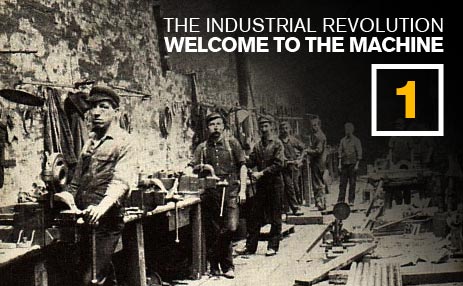Latest
-
Objections to the Christian Faith from the Unchurched and De-Churched
 Tue Dec 02, 2014
Tue Dec 02, 2014
by Resurgence -
Craig Groeschel: We Innovate for Jesus
 Tue Oct 14, 2014
Tue Oct 14, 2014
by Resurgence -
Mark Driscoll: Revelation
 Tue Oct 07, 2014
Tue Oct 07, 2014
by Resurgence -
RESURGENCE LEADERSHIP #034: JOHN PIPER, WHY I TRUST THE SCRIPTURES, PART 2
 Tue Sep 30, 2014
Tue Sep 30, 2014
by Resurgence -
Resurgence Leadership #033: John Piper, Why I Trust the Scriptures, Part 1
 Tue Sep 23, 2014
Tue Sep 23, 2014
by Resurgence

Archives
The Industrial Revolution: Welcome to the Machine, Part 1

Reproducible Culture
Control was king. It was the valued currency of the period known as the Industrial Revolution. The value of that revolution was identical production. If you could create the system and reproduce the movements, then you could assemble each time-and-again without variation of product. The great emblem of this was the factory. On the assembly line men stood repeating, like gears, identical motions. Each time, if the system worked, at the end of the line came a finished product exactly like the one before and after. If the factory was the place where this happened, then the automobile was the everyday icon of the age. The Industrial Revolution brought about a time of great economic growth and change. It was what futurist Alvin Toffler would call "The Second Wave." The first was the Agrarian Era. It was localized, offered little change, and was reproduced organically. It was tied to the earth and the seasons of the farming cycle. Man was closely related to a patch of land and slow repeating rhythmic cycles that would produce sustenance.
Factory-Made World
The Industrial Age allowed a level of control that would shift this balance. Mass production would remove the organic connections, the small tribal units, and the homesteading family. It would create, instead, a homogenization. The unintended byproduct (and with technological changes there always are unintended byproducts) would be the creation of a homogenized society. The success of the factory would drive others to imitate it. The school system became, and sadly still exists as, an arcane tribute to the factory. Students would sit in rows of identical seats. Lunch bells, like work whistles, would ring. The students would exit the school room, much like a factory floor, and reassemble on another part of the factory assembly line, whether it be mathematics or history. The new foreman was the teacher, who would teach every student the exact same data in the exact same way.
The Rate of Change
Sociology is important as it points to the church. The church has always existed within a culture. When I use the term culture, I am referring to a set of words, cues, and artifacts that are understood by a group without need for translation. They are automatic; they are the fabric of communication and life. Culture moves along and is impacted by a rate of change. That rate of change is how quickly we move ideas, goods, and people. As these ideas, goods, and people are moved, cultures—words, cues, and artifacts—are shared and translated. They morph and change and form new invariant cultures. The rate at which the world changed was fairly stable from the time of creation through the Agrarian Age. The speed at which horses dragged chariots and carts made little difference between biblical times and the founding of the American colony. Sails on ships became more massive and the ships larger, but the speed of sea travel stayed relatively constant. The Industrial Revolution would radically change this, creating a large chasm. The movement of information and ideas would now be forced by steel and pumping pistons, explosions happening at a molecular level, and the instant bangs would move people across continents and move mankind ever faster to what it would know as the future. To be continued.